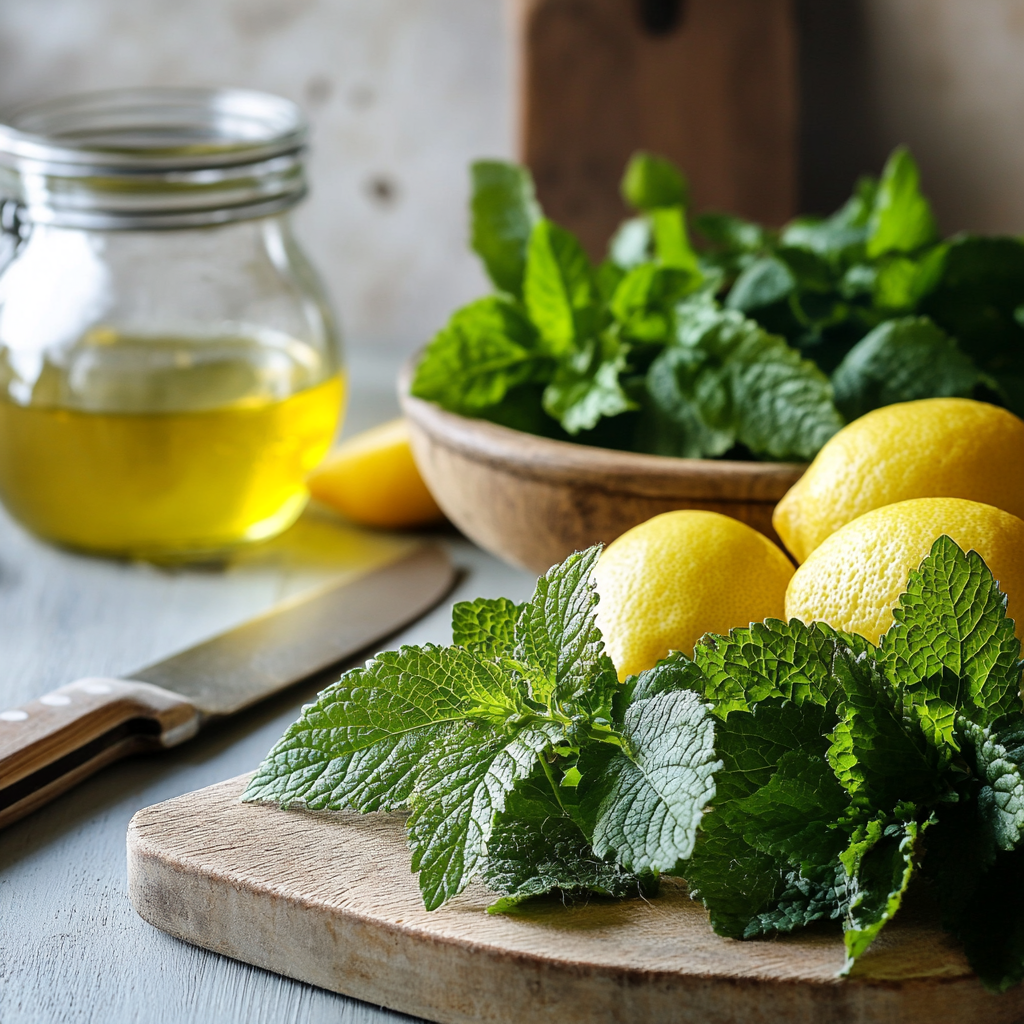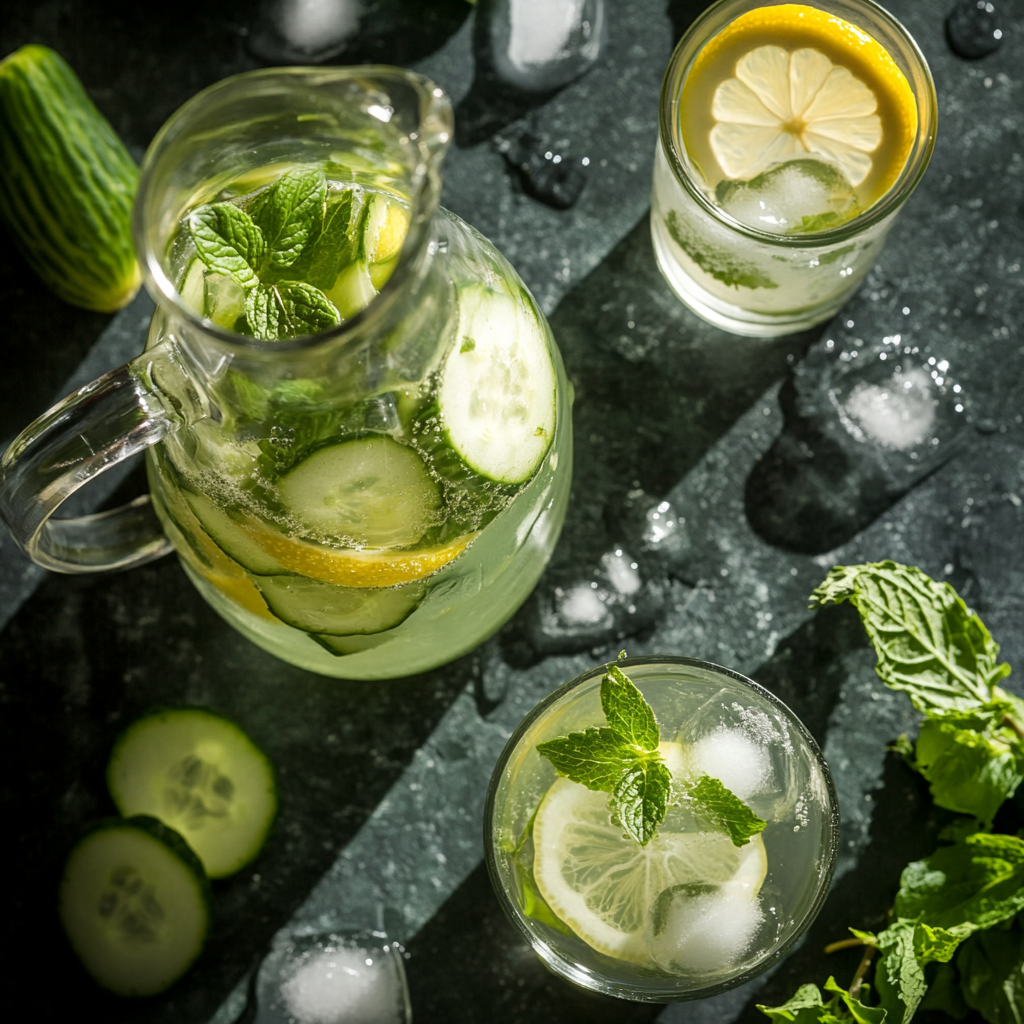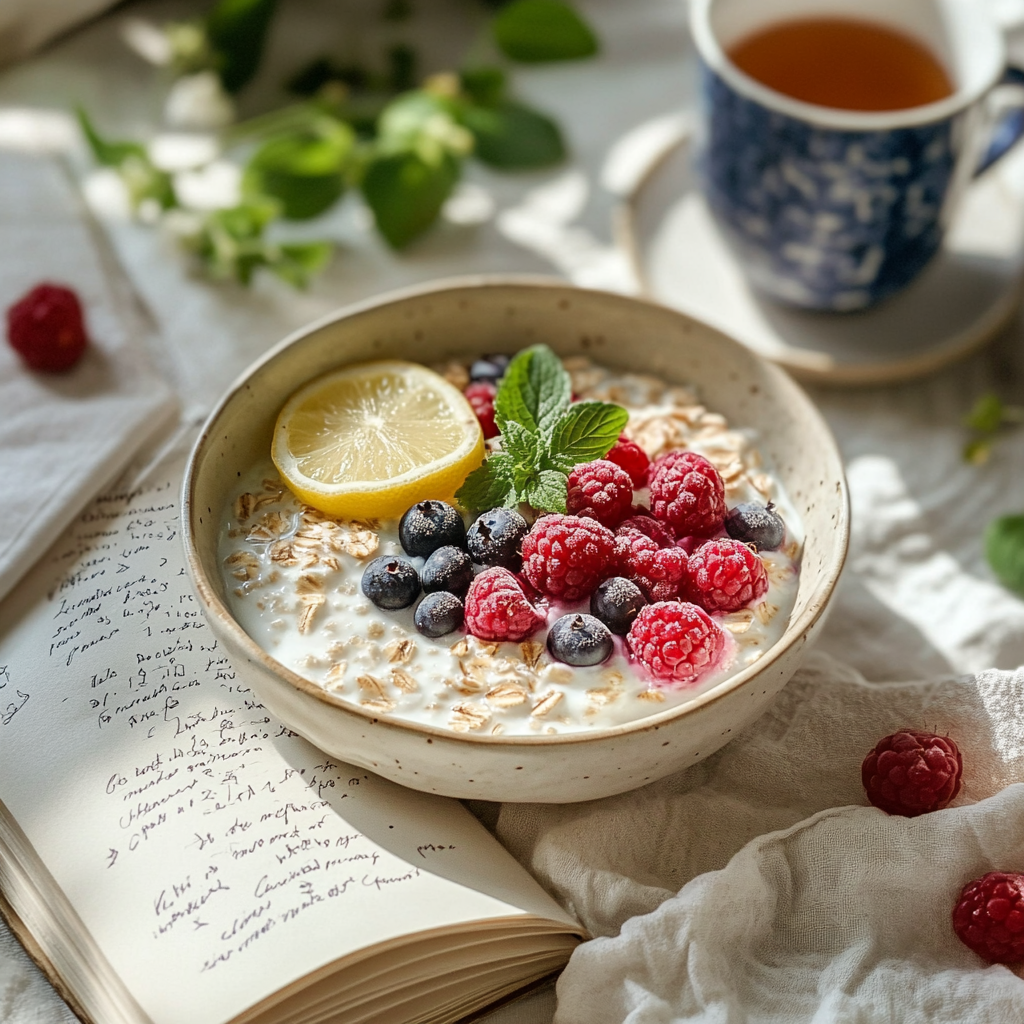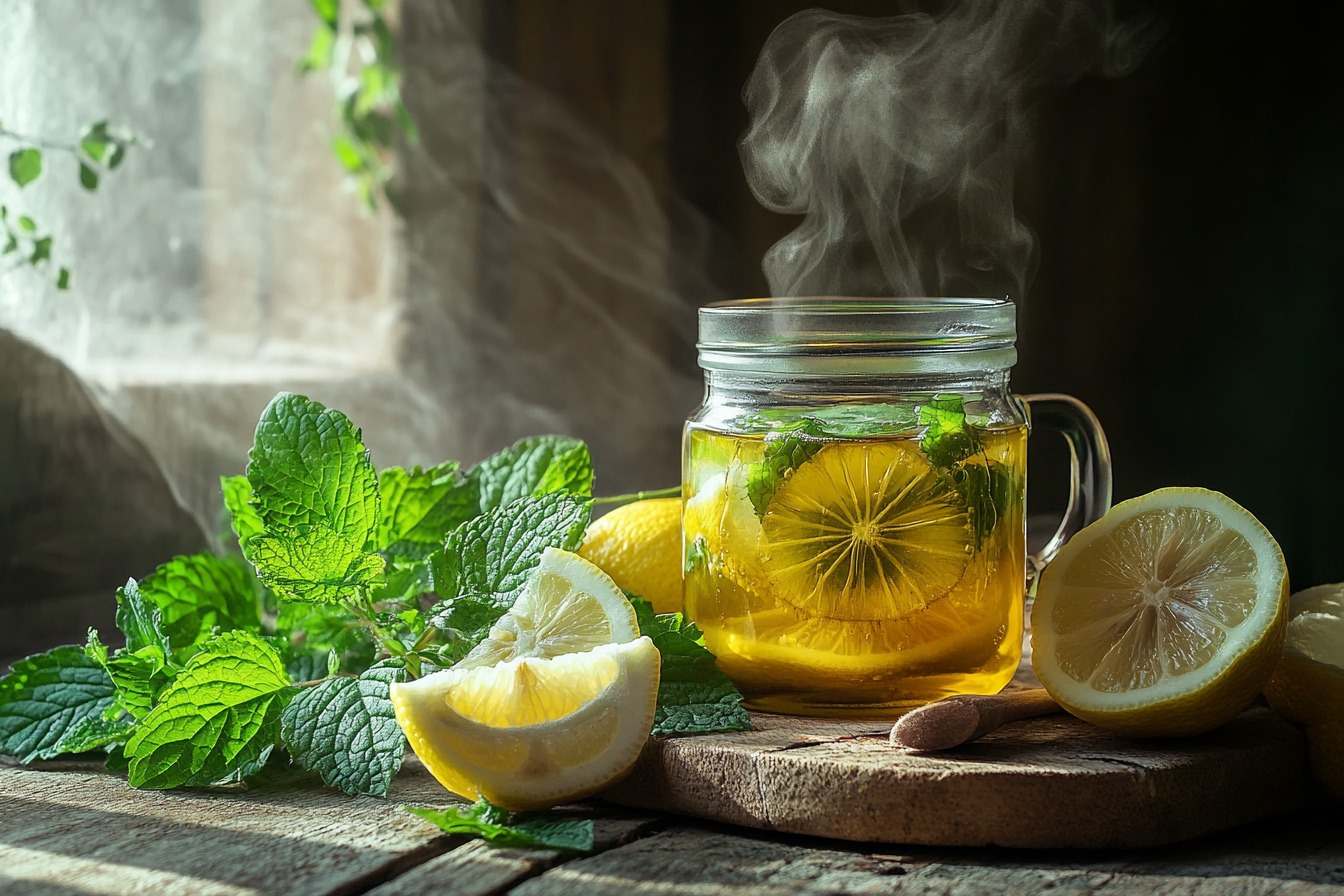Back in Vermont, summer meant warm breezes, honey-sweet tea, and lemon balm growing wild by my grandma’s porch. I didn’t know it then, but those fragrant green leaves would shape so many of my favorite recipes today. Now based in Dubai, I still keep lemon balm on hand to bring brightness to my cooking. It’s a quiet, gentle herb—but don’t underestimate it. Whether I’m adding it to dessert or stirring it into herbal tea, I love how it instantly lifts any dish. In this article, I’ll share easy, vibrant recipes using lemon balm—from fresh drinks and salads to herbal twists on sweets.
Table of Contents
Table of Contents

Recipes Using Lemon Balm That Brighten Every Meal
- Total Time: 17 minutes
- Yield: 2 servings (tea) + 3/4 cup syrup
- Diet: Vegetarian
Description
Recipes Using Lemon Balm – this two-in-one recipe combines a calming lemon balm honey tea and a fragrant herbal syrup. It’s perfect for soothing sips, wellness routines, and easy homemade flavor infusions.
Ingredients
FOR THE TEA:
– 1 cup fresh lemon balm leaves (lightly packed)
– 1 tsp raw honey (or to taste)
– 1.5 cups hot water
FOR THE SYRUP:
– 1/2 cup fresh lemon balm leaves
– 1/2 cup water
– 1/2 cup organic sugar or honey
Instructions
1. To make the lemon balm tea, rinse and lightly crush the leaves.
2. Pour hot water over the leaves in a mug and cover.
3. Let steep for 5–7 minutes, then strain.
4. Stir in honey and serve warm.
5.
6. To make the herbal syrup, combine lemon balm, water, and sweetener in a saucepan.
7. Bring to a gentle simmer and cook for 10–12 minutes.
8. Let it cool slightly, then strain out the leaves.
9. Store in a glass jar in the fridge for up to 10 days.
10. Use in drinks, over desserts, or in salad dressings.
Notes
• For stronger tea, steep the lemon balm leaves longer or add more.
• The syrup can be used in mocktails, drizzle over yogurt, or added to sparkling water.
• You can substitute honey with maple syrup for a vegan option.
- Prep Time: 5 minutes
- Cook Time: 12 minutes
- Category: Drinks, Herbal Wellness
- Method: Steeped, Simmered
- Cuisine: Herbal, Homemade
Nutrition
- Serving Size: 1 cup tea or 1 tbsp syrup
- Calories: 45
- Sugar: 9g
- Sodium: 2mg
- Fat: 0g
- Saturated Fat: 0g
- Unsaturated Fat: 0g
- Trans Fat: 0g
- Carbohydrates: 11g
- Fiber: 0g
- Protein: 0g
- Cholesterol: 0mg
PART 1: Everyday Cooking With Lemon Balm
Simple Ways to Use Lemon Balm in the Kitchen
If you’ve ever wondered how to actually use lemon balm in recipes, here’s the good news: it’s incredibly versatile. Recipes using lemon balm can be as simple as tossing chopped leaves into a fruit salad or steeping them in a mug of hot water. The herb adds a clean, lemony note that pairs beautifully with both savory and sweet ingredients.
The flavor is milder than mint but still gives a dish that fresh, garden-picked feel. One of the easiest recipes using lemon balm is a quick homemade tea—just pour hot water over a handful of fresh leaves. You’ll get an instant sense of calm and clarity with every sip. You can find a soothing version of this lemon balm recipe here.
How to Prepare Lemon Balm the Right Way

Fresh lemon balm is delicate, so a gentle hand goes a long way. Rinse it carefully and pat it dry with a towel. When chopping, use a sharp knife or snip it with kitchen scissors to preserve its oils. For recipes using lemon balm in hot dishes, always add it toward the end of cooking. Prolonged heat can fade its bright flavor.
If you grow lemon balm yourself, harvest it in the morning—this is when its essential oils are at their peak. You’ll know it’s ready when the leaves give off a strong lemony scent with a hint of mint.
Don’t forget, lemon balm isn’t just for tea or savory meals. It makes an amazing addition to desserts too. A few finely chopped leaves can bring a fresh twist to cookies or cakes. Or add it to any treat from this vegan dessert collection for an herbal citrus upgrade.
Creative Recipes Using Lemon Balm for Sweets & Sips
Lemon Balm in Desserts You’ll Want Again and Again

When it comes to desserts, lemon balm has a way of making flavors feel cleaner and brighter. It’s like adding a breeze to your baking. Recipes using lemon balm in sweet dishes are simple to create yet feel gourmet. Think lemon balm paired with honey in a light glaze, or finely minced and added to a lemon loaf for a garden-fresh aroma.
You can even swap it in where you’d usually use mint—like in fruit salads, popsicles, or even in a dairy-free panna cotta. Its soft citrus flavor pairs wonderfully with berries, vanilla, or even light coconut-based desserts. Want a subtle yet stunning finish? Infuse lemon balm into your sugar by blending dried leaves into raw cane sugar. Dust it over shortbread or use it in baking for a hint of herbaceous sweetness.
For a fresh dessert twist that aligns with mindful eating, the herb also blends beautifully into guilt-free recipes. Some of the best plant-based desserts get a little upgrade when lemon balm steps in as a secret ingredient—bringing flavor without fuss.
Cooling Lemon Balm Drinks and Herbal Sips
Nothing beats a chilled lemon balm drink on a hot day. This herb was practically made for refreshing recipes. One of the easiest ways to enjoy it is in a homemade lemonade—just muddle a handful of lemon balm leaves with lemon juice and honey, then top with still or sparkling water. You’ll have a naturally sweet, herbal cooler that’s far more interesting than store-bought.
Looking for something more functional? Lemon balm also complements cleansing ingredients like pink Himalayan salt and citrus, making it ideal for wellness drink recipes that support hydration and calm. If you’re experimenting with detox blends or morning tonics, try steeping lemon balm with fresh ginger and a pinch of mineral-rich pink salt for a gentle start to the day.
And for a soothing bedtime ritual, brew a simple lemon balm and chamomile tea. For more on herbal and wellness-focused blends, take a look at this balanced salt-based approach that works hand in hand with lemon balm’s calming nature.

PART 3: Smart Ways to Preserve and Pair Lemon Balm
How to Preserve Lemon Balm for Year-Round Recipes
One of the best things about using lemon balm is how easily it can be preserved. If you’re serious about creating recipes using lemon balm year-round, learning to store it properly is key. Once fully dried, crumble them into an airtight jar and store away from sunlight.
Prefer a fresh option? Try freezing chopped lemon balm in ice cube trays. Just fill each cube with a teaspoon of chopped leaves and top with water or olive oil. Pop them into your next soup, stew, or salad dressing and enjoy the bright citrusy flavor any time of year. These cubes are especially useful in chilled recipes using lemon balm like summer soups or infused broths.
Another trick is to make a simple herbal vinegar. Add a handful of lemon balm to white wine vinegar and let it sit for two weeks. You’ll end up with a bright, fragrant liquid perfect for dressings and marinades. For a herbal balance that also supports wellness, use it alongside natural mineral-based blends like the ones explored in this salt-enhanced recipe method.
Pairing Ideas for Everyday Cooking With Lemon Balm
Lemon balm shines when paired thoughtfully. Because it’s subtle, it plays well with gentle ingredients—think citrus fruits, mild cheeses, or light proteins like chicken and white fish. It also enhances herbal blends with mint, basil, or chamomile. In cold dishes, lemon balm adds a garden-fresh note without dominating the flavor.
When making savory recipes using lemon balm, mix it into a yogurt-based sauce for roasted vegetables or as a topping for grain bowls. For something fast, blend it with garlic, lemon zest, and olive oil for an easy herb paste that works wonders on grilled proteins.
And don’t overlook breakfast. Add chopped lemon balm to berry compote, overnight oats, or even your morning smoothie. The fresh aroma lifts the entire dish while keeping things clean and natural. Lemon balm is also perfect for calming herbal tea blends, especially when paired with magnesium-rich additions like pink salt.
No matter the recipe, lemon balm helps you cook with intention—bringing freshness, wellness, and gentle flavor into your kitchen every day.
PART 4: Daily Wellness and Lifestyle Recipes Using Lemon Balm
Lemon Balm for Everyday Energy and Calm
Lemon balm is one of those rare herbs that supports both calm and clarity. That’s exactly why I love building daily recipes using lemon balm—not just for flavor, but also for what it does for my mood. Whether it’s part of your morning tea or blended into a lunch bowl, this herb brings gentle balance to your routine.
Start your day with a lemon balm tonic: combine fresh lemon balm, a squeeze of lemon juice, and warm water. It’s a light way to hydrate and awaken without caffeine. At lunch, mix chopped lemon balm into quinoa or sprinkle it over a cucumber salad. Recipes using lemon balm don’t need to be complex—just consistent. The more you use it, the more intuitive it becomes to reach for it instead of stronger, overpowering herbs.
For those who feel stress or digestive tension throughout the day, incorporating lemon balm into meals can create natural support. Its compounds have been studied for their calming effects, making it one of the best herbs to use regularly. Even if you’re not cooking a full dish, steeping a few leaves in water or blending them into a smoothie is a quick way to feel refreshed.
Making Lemon Balm a Long-Term Part of Your Routine

Once you begin exploring recipes using lemon balm, it becomes clear how many possibilities it unlocks. Keep a small bunch on your counter to remind yourself to use it daily. Add it to sauces, soups, vinaigrettes, or even grain bowls. You’ll start seeing how a small touch of herbal citrus can shift the entire flavor of a meal.
To stay consistent, plan one or two weekly recipes using lemon balm that you rotate—like a salad dressing, herbal syrup, or infused oil. These staples can transform other dishes without extra work. Over time, this habit builds into a kitchen rhythm where lemon balm becomes part of your language of cooking.
You don’t need to change your entire diet—just fold lemon balm into what you already love. Whether you’re aiming for better focus, lighter meals, or just a bit more joy at the table, these small additions stack up. Let this gentle herb lead the way toward a kitchen that’s both nourishing and calm.
FAQ: Recipes Using Lemon Balm
What can I do with fresh lemon balm?
Fresh lemon balm can be used in countless ways. Some of the most popular recipes using lemon balm include herbal teas, infused syrups, lemon balm vinaigrettes, and light pestos. You can also chop it into fruit salads or add it to lemon-based baked goods. The herb pairs especially well with citrus, berries, and mild cheeses, offering a refreshing twist in everyday meals.
Can lemon balm be used for cooking?
Yes, absolutely. Lemon balm is a versatile herb ideal for cooking. Recipes using lemon balm range from sweet to savory—think herbed butters, grilled chicken marinades, lemon balm sauces, and even calming soups.
What is lemon balm best used for?
Lemon balm is best used in recipes that benefit from a mild citrus flavor. It shines in recipes using lemon balm such as infused teas, honey glazes, herbal desserts, and light summer pastas. Aside from flavor, lemon balm is also known for its calming properties, making it ideal for daily wellness recipes.
Can you eat raw lemon balm?
Yes, raw lemon balm is safe and delicious. It’s commonly used raw in salads, smoothies, or as a garnish for desserts. Many recipes using lemon balm rely on the fresh version to capture its delicate aroma and natural oils. Just be sure to rinse it gently and use it shortly after harvesting for the best flavor.
Conclusion: Recipes Using Lemon Balm
Lemon balm is more than a pretty herb—it’s a quiet powerhouse in the kitchen. From light teas to garden-fresh desserts, recipes using lemon balm add a refreshing note that elevates everyday meals. Whether you’re just beginning to cook with herbs or you’re already blending flavors with confidence, lemon balm deserves a permanent spot in your pantry.
The beauty of recipes using lemon balm is their flexibility. You can start small—toss it in a salad, stir it into a honey glaze, or steep it for a calming drink. Over time, it naturally becomes part of your cooking rhythm. You’ll reach for it not just for its flavor, but for the ease and calm it brings to your plate.
Let this gentle, citrusy herb guide you toward recipes that are both flavorful and nourishing. From savory to sweet, hot or cold, there’s no limit to what you can create with lemon balm in your kitchen.
Stay Inspired Beyond the Recipe
Loved these recipes using lemon balm? There’s more where that came from!
Follow me on Facebook, Pinterest, and Medium for fresh ideas, behind-the-scenes baking moments, and kitchen-tested recipes that bring joy to your table.
I share exclusive seasonal treats, herbal kitchen tips, and sweet inspiration you won’t find anywhere else. Let’s keep the sugar and smiles going—join our community of women who love to cook, create, and celebrate food that feels good.

